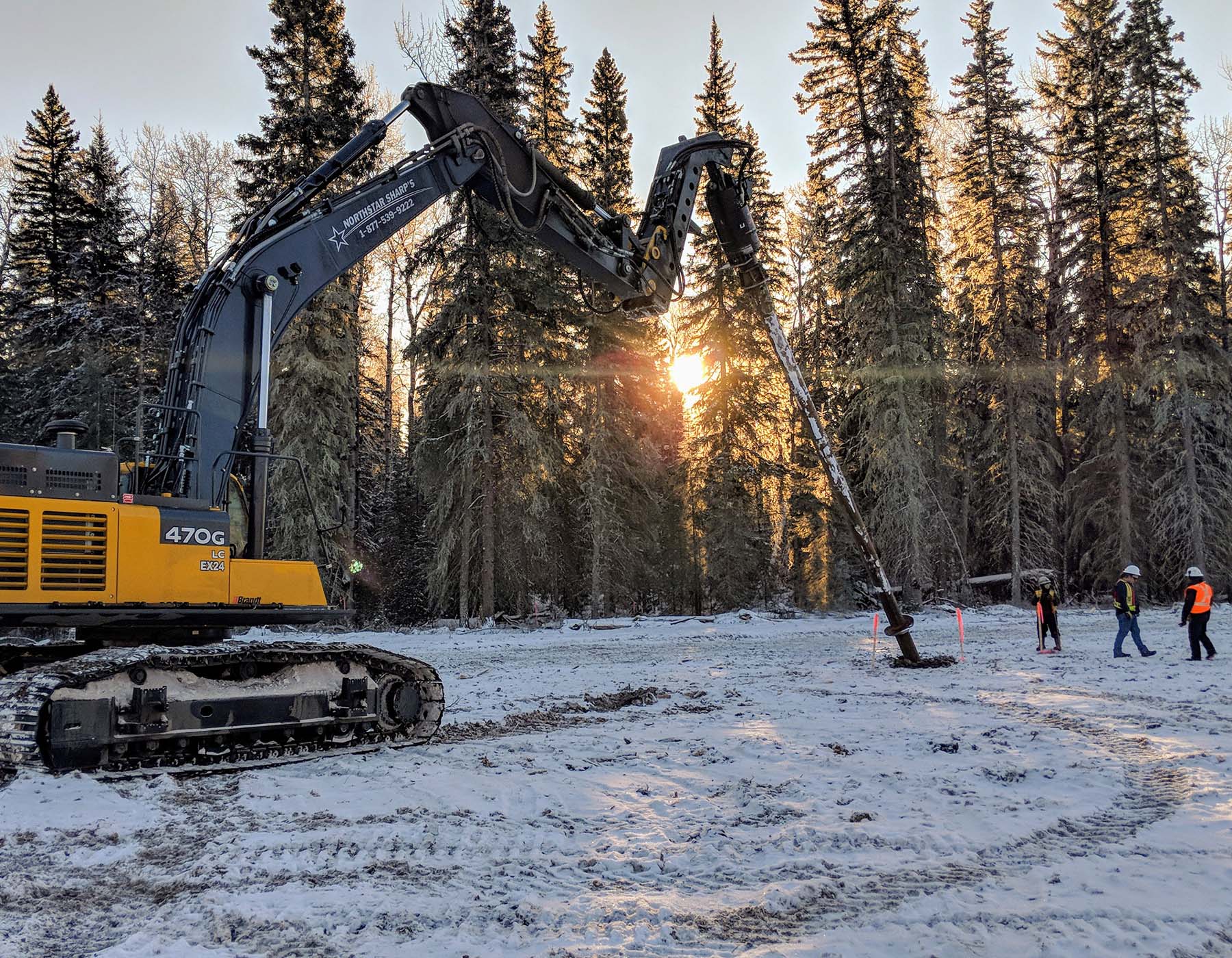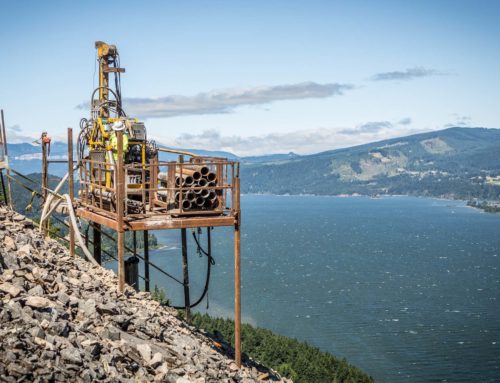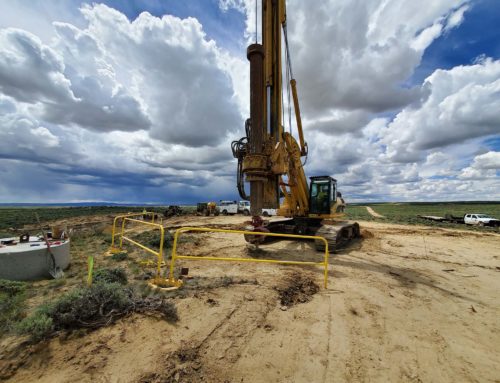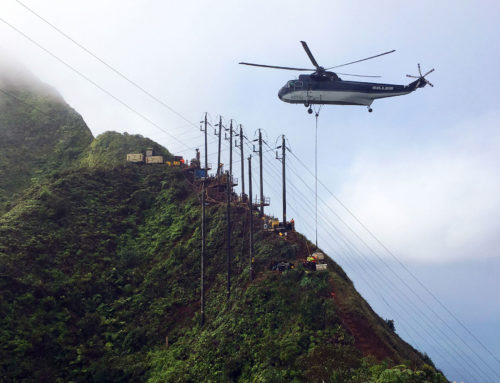Integration of Geotechnical Investigation, Foundation Design, and Construction
Introduction
The West Fort McMurray (WFMAC) 500 kV Transmission Line Project includes over 500 km (310 mi) of high voltage transmission line, expansion of an existing substation, and construction of a new substation, all located in Northcentral Alberta, Canada. Contracted in 2014, it was, at that time, the largest Engineering, Procurement, and Construction (EPC) project ever awarded in North America.
Transmission line construction consisted of a variety of structure types, including self-supporting lattice steel towers, guyed towers, and tubular steel poles, supported by a variety of foundation types, including driven piles, drilled shafts, and helical anchors. Development of detailed foundation designs in advance of construction was challenged by limited available geotechnical information and an undeveloped transmission alignment. Soft, peaty soils, known locally as muskeg, cover much of the alignment, requiring structure locations to be accessed by extensive matting or ice roads and rendering an early geotechnical investigation program impractical. In order to provide an efficient and detailed foundation design and construction approach without significant impact to the project schedule, the EPC team developed preliminary soil profiles and foundation designs based on a detailed geotechnical desktop study. These profiles and designs were validated through a detailed geotechnical investigation program conducted in conjunction with foundation construction.
This paper will detail the process employed to successfully design and construct foundations in the face of the described challenges. Four basic steps – geotechnical desktop study and subsurface profile development; design of preliminary foundation types; preliminary profile and foundation assignment; and in-construction geotechnical investigation and confirmation – are outlined, which demonstrate how an integrated approach combining geological, geotechnical and structural design efforts can serve to optimize foundation design and construction. The paper concludes with an illustration of the geotechnical investigations for approximately 40 structure locations within the Lesser Slave River Valley, where cone penetrometer testing (CPT) investigations facilitated on-the-fly modifications to foundation designs when soft soils were unexpectedly encountered.

Horizontal drill rig set up in bottom of Las Vegas Wash Tunnel shaft
Authors:
Brian J. Olson, P.Geo, C.E.G. – Senior Engineering Geologist, Quanta Subsurface
Justin Toney, P.E. – Senior Engineer, Quanta Subsurface
Preliminary Geotechnical Desktop Study
Preliminary project planning identified two potential alignments between Edmonton and Fort McMurray, neither of which had been substantially investigated. Pre-existing geological data was compiled to perform a comprehensive desktop study in advance of construction, which would assist the team in developing soil profiles and preliminary foundation designs, and ultimately select the preferred alignment.
Much of the pre-existing geological data can be attributed to the significant presence of the petroleum industry in Alberta. This data provided the project team with information on landforms, soil thickness, hydrology, surficial geology and bedrock geology in the region. Overall, compiled resources included more than 40 maps and reports published by local agencies. Geologic maps that met the necessary scale requirements (between 1:100,000 and 1:250,000) were also georeferenced and compiled into a Geographic Information System (GIS) platform to be associated with preliminary alignment spotting.
Additional data incorporated in the study included borings along potential alignments and at planned substation locations. Between 2011 and 2016, a total of 18 borings and 16 CPT soundings were performed along multiple proposed routes, although most were not located on one of the two final routes selected. These data points were supplemented by approximately 150 borings performed for the Trans-Canada Pipeline project, located south of Fort McMurray. Although shallow, the borings provided reliable insight on the depth and quality of the loose muskeg or peaty soils common in the region.
Subsurface uncertainty significantly decreased in the areas surrounding the two substations due the ease of access and ability to perform higher quality geotechnical investigations. In total, 33 borings with laboratory tests were obtained, resulting in more detailed development of subsurface profiles in these regions.
The variety of data obtained and compiled required a significant amount of interpretation by the project team. Additional clarity on the expected conditions was gained by shared experience with local foundation and overhead contractors familiar with construction in the area. Although the compiled data was not comprehensive and inconsistent at times, it provided the team an indication of the primary geologic characteristics expected to be encountered in the general area of the project. The western route was ultimately chosen as the preferred right-of-way (ROW), and preliminary structure spotting was performed by the overhead engineer to provide preliminary structure locations.
Preliminary Subsurface Profiles
With the route selection, preliminary structure spotting and subsurface profiles in place, preliminary foundation designs could be developed. Foundation loading and structure connections were provided by the overhead engineer, and the foundation engineer developed preliminary foundation solutions for each structure type and geotechnical profile combination. Initially, grillage and shallow foundations, drilled shafts, driven H- and pipe piles, helical piles, and micropiles were considered for the primary foundation types, with grouted anchors, driven pile anchors, and helical anchors considered to support guy wire loading. The engineer and contractor collaborated through constructability reviews, and preferred foundation solutions were identified with consideration to foundation sizing, constructability, efficiency, material availability, and quality assurance, among other things.
Generally speaking, shallow pad and grillage foundations are efficient solutions when access and geotechnical conditions allow for excavation and compaction of onsite materials. However, poor and unstable overburden materials may require substantial excavation footprints and additional measures to stabilize the work area. Additionally, the use of shallow footings is generally limited to locations where suitable shallow bearing material is encountered. The potential for encountering deep organic and soft clayey materials made large-scale use of shallow foundations unlikely. Accordingly, these foundation types were eliminated as possible options.
The high probability of encountering deep organic and soft clayey conditions proved ideal for driven pile and helical pile foundation solutions since these foundations can be easily installed through poorer overburden conditions to suitable, deep bearing materials. Initially, both H-pile and pipe pile sections were considered for driven pile solutions; however, pile construction tolerances and contractor feedback eliminated H-pile sections as their performance and strength are greatly affected by small sensitivities in positioning relative to the orientation of loading. The performance and strength of closed, symmetric pipe pile cross sections is identical regardless of orientation to loading, making them the preferred option for pile group foundations. The ability of driven piles to develop full bending capacity across complete joint penetration weld splicing made them the ideal choice for self-supporting lattice steel towers and center masts of guyed structures where lateral forces can be high at the structure-to-foundation connection.
Preliminary Foundation Types
With the route selection, preliminary structure spotting and subsurface profiles in place, preliminary foundation designs could be developed. Foundation loading and structure connections were provided by the overhead engineer, and the foundation engineer developed preliminary foundation solutions for each structure type and geotechnical profile combination. Initially, grillage and shallow foundations, drilled shafts, driven H- and pipe piles, helical piles, and micropiles were considered for the primary foundation types, with grouted anchors, driven pile anchors, and helical anchors considered to support guy wire loading. The engineer and contractor collaborated through constructability reviews, and preferred foundation solutions were identified with consideration to foundation sizing, constructability, efficiency, material availability, and quality assurance, among other things.
Generally speaking, shallow pad and grillage foundations are efficient solutions when access and geotechnical conditions allow for excavation and compaction of onsite materials. However, poor and unstable overburden materials may require substantial excavation footprints and additional measures to stabilize the work area. Additionally, the use of shallow footings is generally limited to locations where suitable shallow bearing material is encountered. The potential for encountering deep organic and soft clayey materials made large-scale use of shallow foundations unlikely. Accordingly, these foundation types were eliminated as possible options.
The high probability of encountering deep organic and soft clayey conditions proved ideal for driven pile and helical pile foundation solutions since these foundations can be easily installed through poorer overburden conditions to suitable, deep bearing materials. Initially, both H-pile and pipe pile sections were considered for driven pile solutions; however, pile construction tolerances and contractor feedback eliminated H-pile sections as their performance and strength are greatly affected by small sensitivities in positioning relative to the orientation of loading. The performance and strength of closed, symmetric pipe pile cross sections is identical regardless of orientation to loading, making them the preferred option for pile group foundations. The ability of driven piles to develop full bending capacity across complete joint penetration weld splicing made them the ideal choice for self-supporting lattice steel towers and center masts of guyed structures where lateral forces can be high at the structure-to-foundation connection.
With over 4,000 individual guy anchors required on the project, helical piles were chosen as the primary anchor solution. Their bolted connections allowed for quick and simple splicing that could resist the pure tension loading applied to the anchor. Grout anchors were also developed as a solution for profiles expected to encounter shallow hard conditions such as hard clays or sedimentary bedrock.
Given their ability to resist high lateral and overturning forces, drilled shafts were selected as the primary foundation option for tubular steel pole structures. Drilled shafts exhibit versatility in a variety of geotechnical conditions, including the easily-augered shale bedrock, making them a viable solution for guyed anchors, lattice tower foundations, and guyed center mast foundations in hard subgrade conditions as well.
Preliminary Profile and Foundation Assignment
With structure spotting in the preliminary stages, and site clearing and access not yet performed along the alignment, the project geologic maps and other aerial data were heavily relied upon at locations where borings and other data were still lacking. Overlaying structure locations with geologic maps and considering the various data points reviewed as part of the desktop study allowed geologists to develop preliminary structure-to-soil profile assignments and estimate the expected conditions to be encountered during foundation construction.
Preliminary foundation designs were assigned to each structure location with primary consideration to combination of structure type and anticipated soil profile. Additional variables which influenced the assignments included planned construction access and equipment mobilization strategies, distance to resources such as concrete batch plants, and contractor preference.
Upon selection of the final route, and with preliminary soil profiles and foundation designs complete, the contractor was able to develop construction strategies and begin early material procurement. Driven piles and helical pile anchors utilized similar sizing to maximize sourcing of available materials, and approximately two thirds of the estimated foundation materials were purchased in advance. The rest of the purchasing was postponed to maintain flexibility during construction in anticipation of potential profile changes.
In-Construction Investigation Program
The comprehensive in-construction geotechnical investigation program was vital to confirming anticipated design soil profiles and foundation assignments at each structure location. Typically, geotechnical investigation programs for transmission line projects are much less comprehensive. They might consist of borings at each dead end or large angle structure, and along the rest of the alignment at approximately 1 km (0.6 mi) intervals. For this project however, the program included investigation at each individual structure location to allow for optimized application of the available foundation designs.
Project permitting allowed for limited construction clearing in the winter of 2016-2017, facilitating structure-specific geotechnical borings to be drilled at a total of 212 sites before foundation construction commenced summer of 2017. Although a relatively low percentage of the total 1,368 structure locations, this initial project-specific investigation enabled a proof of concept for the design and construction strategy. Individual borings provided detailed assessment of the site geology and assignment of a construction-specific soil profile. Final foundation selections were correlated to the encountered soil profiles, and final construction requirements were incorporated into the approved foundation design documents.
Once ROW clearing was fully permitted, all-terrain geotechnical drill rigs were mobilized to multiple active work fronts, with two to five drill crews active at any given time. At many locations, full access clearing had not been completed before the geotechnical work crew arrived. This resulted in approximate structure locations being occupied using handheld GPS devices programed with alignment staking data. Trained geologists accompanied each drill crew, collecting Standard Penetration Test (SPT) readings, logging the subsurface profile, and recovering samples for visual observations and potential laboratory testing. Data obtained at every structure location was reviewed by the geotechnical engineer for acceptance of onsite conditions and final foundation selection before commencement of site-specific foundation construction. In the end, the geotechnical investigation program confirmed design soil conditions and existing foundation designs at all but three percent of the 1,368 structure locations.
Lesser Slaver River Valley Characterization
A handful of structures near the middle of the alignment were located in the Lesser Slave River Valley. ROW clearing and geotechnical investigation crews started predominately on the north and south end of the alignment working towerds the center. Accordingly, this was one of the last areas on the alignment to be cleared and investigated. The river crossing itself was relatively narrow, spanning 436 m (1,433 ft); however, geotechnical investigations suggested the river valley was much broader, consisting of a topographic plain approximately 15 km (9 mi) wide.
The desktop study had revealed the potential for soft clays in the greater region near the river; however, available borings at the time were located north and south of the river and did not fully capture the reach of the river valley. Although soft soil profiles were anticipated, the geotechnical investigation indicated soft clays to much greater depths than were planned for in design or encountered elsewhere along the alignment. SPT readings of 10 blows per 30 cm (1 ft) and less were encountered at depths of 30 m (98 ft) or more, whereas assigned soil profiles from the desktop study anticipated values of 15 or greater below 10 m (33 ft). Ultimately, adequate soil stiffness was not encountered to accommodate existing foundation designs. Further geologic review indicated that ancient glacio-lacustrine lakebed deposits associated with the larger ancestral Slave Lake, present during the past glaciation, had resulted in significant depths of soft soils in this region.
The deep, soft soils encountered in the valley were problematic because foundations had not been designed and procured for these conditions. The SPT geotechnical rigs were inefficient, requiring at least a full day to drill and sample to the 30+ m (100+ ft) depths required.
To accelerate the investigation and protect the project schedule, CPT soundings were eventually performed at the affected structures. Although this investigation method is well-established in the geotechnical industry and highly effective in soft soils, the method does not allow for collection of physical soil samples to identify the exact makeup of the soil, and must be correlated against traditional investigative methods to establish confidence in the characterization. A
specialty contractor was quickly mobilized, inserting a 3.5 cm (1.4 in) diameter cone into the subsurface material to collect data on the soil strata stiffness, grain size, and degree of saturation. Initial CPT readings were compared with adjacent SPT borings to provide correlations to necessary soil strength properties for foundation analysis, and the remaining locations were investigated solely with the use of the CPT readings. In the course of one week, the contractor successfully obtained data to depths up to 30 m (98 ft) at all 36 structure locations in the valley. The CPT readings confirmed that encountered geotechnical conditions did not match any of the defined soil profiles. After reviewing the data, four additional soft-strata profiles were developed. Analysis of existing foundation options indicated that current driven pile designs could be implemented in the valley with significant extension to the design pile lengths. Although a viable option, driven pile extensions required complete joint penetration welds, which add significant time to installation durations to accommodate pile cut-off, preparation, and weld and inspection activities for each splice.
The contractor suggested the use of helical piles since the material sizing was similar to the driven pile designs and the bolted splice configuration allowed for a much quicker installation. The original helical pile splices were not designed to accommodate the large pile bending demands imparted by the structure loading in the soft soils; however, a field-installed fillet weld was implemented to reinforce the splice connection and resist the bending forces. With a solution in hand, foundation construction in the valley region commenced on February 16 and was substantially completed on March 8. Final pile embedment depths reached as deep as 48 m (157 ft).
Summary of Project Success
Foundation construction for the 1,368 structure locations along the transmission line ROW were successfully completed in just 14 months, 4 months ahead of schedule. The preliminary geotechnical investigations, although relatively sparse, were supplemented with publicly available geologic data and input from experienced contractors, geologists and geotechnical engineers. Preliminary foundation designs were developed to accommodate the various structure types and anticipated geologic conditions, and allowed for early construction planning and material procurement. In the Lesser Slave River Valley, specialized CPT soundings were able to characterize the very deep, soft glacio-lacustrine clays, enabling rapid deployment of an alternative foundation solution without compromising the project schedule. Geotechnical investigations conducted in parallel with foundation construction activities confirmed encountered subsurface conditions, and allowed for optimization in foundation assignments and construction execution.
Many linear transmission projects experience access challenges caused by permitting, environmental or biological restrictions, or other delays. This often make it impractical to conduct a detailed geotechnical investigation and analysis prior to construction, and may lead to difficulties in developing proper foundation design and efficient construction planning. Uncertainties are often handled with contingencies in construction estimates or schedule delays during construction. This method of early geotechnical analysis and foundation design, complimented with an in-construction geotechnical investigation program, reduced risk to the project and contingent expenditures while delivering constructed foundations ahead of schedule.




